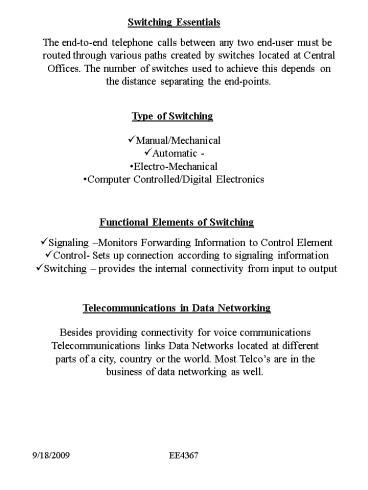Switching Essentials - PowerPoint PPT Presentation
1 / 3
Title:
Switching Essentials
Description:
Complexity NC = NS (MSC MT MTC)/100. where NS = number of cross points in space stages ... MT = time stage memory bits. MTC = time stage control bits. 9 ... – PowerPoint PPT presentation
Number of Views:38
Avg rating:3.0/5.0
Title: Switching Essentials
1
Switching Essentials
The end-to-end telephone calls between any two
end-user must be routed through various paths
created by switches located at Central Offices.
The number of switches used to achieve this
depends on the distance separating the end-points.
Type of Switching
- Manual/Mechanical
- Automatic -
- Electro-Mechanical
- Computer Controlled/Digital Electronics
Functional Elements of Switching
- Signaling Monitors Forwarding Information to
Control Element - Control- Sets up connection according to
signaling information - Switching provides the internal connectivity
from input to output
Telecommunications in Data Networking
Besides providing connectivity for voice
communications Telecommunications links Data
Networks located at different parts of a city,
country or the world. Most Telcos are in
the business of data networking as well.
2
Digital Switching
Functions Setup and Release connections on
demand. Switching Types For Voice
Local, Transit(tandem) and Call Distribution
For Data (including video) Access and Core
Switching Structure
Space Division Rectangular single stage
Multiple-stage
Nonblocking Time Division Analog
Digital
Digital Memory Two Dimensional (Space and
Time Division) STS
(Space-time-space) TST
(Time-space-time)
TSSST (Time-space-space-space-time) Complexity
NC NS (MSC MT MTC)/100 where NS number
of cross points in space stages MSC
space stage control bits MT time
stage memory bits MTC time stage
control bits
3
Switch Type STS TST TSSST
MTC Kclog2c 2Nllog2c 2Nllog2c
MT kc(8) 2Nc(8) 2Nc(8)
MSC 2kclog2N Nllog2N 2k(N/n)llog2n k(N/n)
llog2(N/n)
NS 2kN N 2 2Nk k(N/n)2
Where k number of center-stage time switch
array l number of space stage time
slot c number of channels
N number of input/output lines































